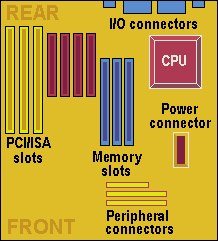The Intel Advanced/ML motherboard, launched in 1996, was designed to solve issues of space and airflow that the Pentium II and AGP graphics cards had caused the preceding LPX form factor. As the first major innovation in form factors in years, it marked the beginning of a new era in motherboard design. Its size and layout are completely different to the BAT format, following a new scheme known as ATX. The dimensions of a standard ATX board are 12in wide by 9.6in long; the mini ATX variant is typically of the order 11.2in by 8.2in.
The ATX design gets round the space and airflow problems by moving the CPU socket and the voltage regulator to the right-hand side of the expansion bus. Room is made for the CPU by making the card slightly wider, and shrinking or integrating components such as the Flash BIOS, I/O logic and keyboard controller. This means the board need only be half as deep as a full size Baby AT, and there’s no obstruction whatsoever to the six expansion slots (two ISA, one ISA/PCI, three PCI).

An important innovation was the new specification of power supply for the ATX that can be powered on or off by a signal from the motherboard. At a time when energy conservation was becoming a major issue, this allows notebook-style power management and software-controlled shutdown and power-up.
A 3.3V output is also provided directly from the power supply. Accessibility of the processor and memory modules is improved dramatically, and relocation of the peripheral connectors allows shorter cables to be used. This also helps reduce electromagnetic interference. The ATX power supply has a side vent that blows air from the outside directly across the processor and memory modules, allowing passive heatsinks to be used in most cases, thereby reducing system noise.
Mini-ATX is simply a smaller version of a full-sized ATX board. On both designs,parallel, serial, PS/2 keyboard and mouse ports are located on a double-height I/O shield at the rear. Being soldered directly onto the board generally means no need for cable interconnects to the on-board I/O ports. A consequence of this, however, is that the ATX needs a newly designed case, with correctly positioned cut-outs for the ports, and neither ATX no Mini-ATX boards can be used in AT-style cases.
- Evolution of the motherboard
- BIOS – What motherboard BIOS does for a PC
- CMOS – complementary metal oxide silicon – RAM chips on motherboards
- EFI – Extensible Firmware Interface – explained
- Motherboard form factors
- Baby AT (BAT) Motherboard Form Factor
- LPX – Low Profile eXtension motherboard form factor
- ATX form factor
- NLX – New Low profile eXtended – form factor for motherboards
- Micro ATX motherboard form factor
- FlexATX motherboard form factor
- BTX – Balanced Technology eXtended – Motherboard Form Factor
- Riser architectures for motherboards
- CPU interfaces – motherboard slots and sockets for AMD and Intel processors